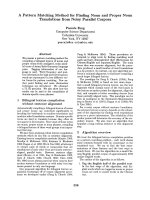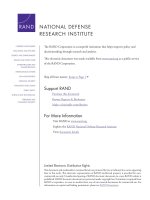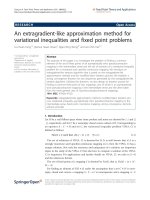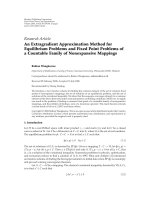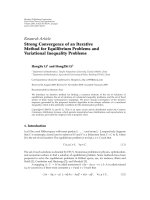Interim Method for Determinationof Melamine and Cyanuric AcidResidues In Foods using LC-MS/MS:Version 1.0
Bạn đang xem bản rút gọn của tài liệu. Xem và tải ngay bản đầy đủ của tài liệu tại đây (407.18 KB, 27 trang )
US FDA/CFSAN - Interim Method for Determination of ...
1 of 27
/>
FDA Home Page | CFSAN Home | Search/Subject Index | Q & A | Help
Laboratory Information Bulletin No. 4422
October 2008
Laboratory Information Bulletin
LIB No. 4422
October 2008
Interim Method for Determination
of Melamine and Cyanuric Acid
Residues In Foods using LC-MS/MS:
Version 1.0
Michael Smoker1 and Alexander J. Krynitsky2
1
Kansas City Laboratory, Office of Regulatory Affairs, Food and Drug
Administration
2
Office of Regulatory Science, Center for Food Safety and Applied
Nutrition, Food and Drug Administration
Abstract
This procedure has been validated for the determination of melamine and
cyanuric acid in both pork and fish tissue using liquid chromatography with
triple quadrupole tandem mass spectrometry (LC-MS/MS) The method has
only been evaluated for performance, but not fully validated, in infant
formula. In this procedure, both cyanuric acid and melamine are extracted
from tissue and infant formula with a 50-50 acetonitrile-water extraction
solution, followed by centrifugation. The cleanup procedures for melamine
involve mix mode cation exchange (MCX) solid phase extraction (SPE) and
that for cyanuric acid uses mix mode anion exchange (MAX) SPE.
Consequently, aliquots of the same extract are individually processed with
the two modes of SPE. The final cleaned up extracts for both melamine and
cyanuric acid are in acetonitrile, making the procedure amenable to evaporate
the excess solvent for sensitivity needs or solvent exchange (depending on
the LC column used). Each compound is analyzed separately using a
zwitterionic HILIC LC column. Electrospray ionization is used in both the
negative ion (cyanuric acid) and positive ion (melamine) modes. Two
selected reaction monitoring (SRM) transitions are monitored for both
compounds. Commercially available, isotopically labeled internal standards
for each compound were used to correct for any matrix effects. The method
limit of quantitation (LOQ) for melamine was: 25 µg/kg for tissue and liquid
formula and 200 µg/kg for dryinfant formula powder. The method LOQ for
09.10.2008 10:45
US FDA/CFSAN - Interim Method for Determination of ...
2 of 27
/>
cyanuric acid was: 50 µg/kg for tissue and liquid formula and 200 µg/kg for
dry infant formula powder. Fortified test portions were within 75-125%
recovery. Determination of incurred residue in tissue agreed well with the
results of an independent laboratory.
This method for Melamine and Cyanuric Acid should be regarded as
interim. Because of the need to rapidly provide this information, the
method has not undergone the rigorous internal and external
validation required for an official method. The performance of the
method may change when different equipment and supplies are
used or when different sample matrices are encountered. The user
should validate the performance of the method in their laboratory
and pay particular attention to the recommended quality control
elements. Users should document with their results the version or
date of the method used.
Introduction
In 2007, pet food, animal feed, wheat gluten, and other protein-based food
commodities were found to contain residues of melamine and a related
compound, cyanuric acid. Widespread pet illness and death was subsequently
attributed to the formation of melamine-cyanurate crystals in the kidneys of
these animals. At that time, several laboratories developed methods for these
compounds in pet food, raw protein sources, and other animal feeds.
Because animals may eat food contaminated with melamine residues,
analytical methods to determine melamine residues in fish and animal tissues
were also developed. Recently, there has been a problem with contamination
of infant formula with melamine and cyanuric acid in China. This is suspected
of causing illness to many children in that country.
A procedure has been validated for the determination and identification of
melamine and cyanuric acid in animal tissue and the same procedure has
been evaluated for the determination and identification of the above in
milk-based infant formula. .
Summary of Procedure
This procedure involves the determination of melamine and cyanuric acid by
LC-MS/MS in animal tissue and infant formula using isotopically labeled
internal standards for each compound in order to correct for matrix effects.
Prior to the extraction procedure, 250 ng of isotopically labeled melamine is
added to the test portion, followed by the addition of 2500 ng of isotopically
labeled cyanuric acid. Tissue samples and liquid infant formula (5 g) are
extracted with 20 mL 50-50 acetonitrile-water in a 50 mL polypropylene
centrifuge tube. For a 1 g sample of dry infant formula, 4 mL of de-ionized
water is first added followed by 20 mL of 50-50 acetonitrile-water. Extracts
are centrifuged at 3750 g and then cleaned up using solid phase extraction.
The cleanup procedure for melamine involves MCX SPE and that for cyanuric
acid uses MAX SPE. Consequently, aliquots of the same extract are
individually processed with the two modes of SPE. The final extracts for both
melamine and cyanuric acid are in acetonitrile, making the procedure
amenable to evaporate the excess solvent for sensitivity needs or solvent
exchange (depending on the LC column used). Each compound is analyzed
separately using a zwitterionic HILIC LC column. Electrospray ionization is
09.10.2008 10:45
US FDA/CFSAN - Interim Method for Determination of ...
3 of 27
/>
used in both the negative ion (cyanuric acid) and positive ion (melamine)
modes. Two selected reaction monitoring (SRM) transitions are monitored for
both compounds.
1. Standards
A. Calibration and spiking concentrations can be varied as needed
B. Internal standard levels can also be adjusted as dictated by instrument
sensitivity and availability of labeled material
C. Melamine
1. Isotopically labeled Melamine (Cambridge Isotope Labs. #CNLM8150-1.2) 13C315N3 labeled Melamine
2. Prepare isotopically labeled Melamine stock solution at 1 µg/mL in
acetonitrile
3. Native Melamine (Aldrich #240818-5G)
a. Stock and Spiking Solutions
Prepare 10 µg/mL solution in 50:50 acetontirile:water
4. Calibration Curve
a. Prepare solutions of 0, 1, 10, 50, 250, and 1000 ng/mL of Native
Melamine in 2% diethylamine/acetonitrile
b. Prepare each calibration solution with isotopically labeled Melamine
at 10 ng/mL
D. Cyanuric Acid
1. Isotopically labeled Cyanuric Acid (Cambridge Isotope Labs. #CNLM4661-1.2) 13C315N3 labeled Cyanuric Acid
2. Alternate Source for Isotopically Labeled Cyanuric Acid: Isotec; 13C3
Cyanuric Acid.
3. Prepare isotopically labeled Cyanuric Acid stock solution at 5 µg/mL
solution in acetonitrile
4. Native Cyanuric Acid (TCI #C0459)
a. Stock and Spiking
Prepare a 10 µg/mL solution in 50:50 acetonitrile:water
5. Calibration Curve
a. Prepare solutions of 0, 10, 50, 200, 500, and 1000 ng/mL Native
Cyanuric Acid in 4% formic acid in acetonitrile
b. Prepare each calibration solution with isotopically labeled Cyanuric
Acid at 100 ng/mL
2. Reagents
A.
B.
C.
D.
E.
F.
Acetonitrile UV grade (Burdick & Jackson #015-4)
Formic Acid 98+% (Riedel de Haën #33015)
Diethylamine (DEA) (Sigma-Aldrich #D0806-1L)
Ammonium Hydroxide, concentrated, redistilled (GFS Chemicals #810)
Water (De-Ionized)
Ammonium Acetate, 99.99+% (Aldrich #431311-250G)
3. Other Consumables
A. 50 mL BD Falcon Bluemax polypropylene graduated tubes, (BD Biosciences
#352098)
B. 15 mL BD Falcon Bluemax Jr. polypropylene graduated tubes (BD
Biosciences #352097)
09.10.2008 10:45
US FDA/CFSAN - Interim Method for Determination of ...
4 of 27
/>
C. 3 mL Norm-Ject AirTite Leur-lock disposable syringes (AirTite Normject
#AL3)
D. Nalgene Non-Sterile PTFE Syringe filters, 0.2 micron, 25 mm (Nalgene
#199-2020)
E. Waters Oasis MCX SPE Cartridges, 6cc 150mg 60 micron (Waters
#18600255)
F. Waters Oasis MAX SPE Cartridges, 6cc 150mg 60 micron (Waters
#18600370)
G. SeQuant ZIC HILIC column, 2.1x150mm PEEK, 5 micron (The Nest Group,
#Q2712-152)
H. Autosampler vials (Waters #WAT094219)
I. Autosampler caps with pre-slit septa (Waters #186002648)
4. Equipment
A.
B.
C.
D.
E.
Standard 24-port SPE manifold (Supelco #57250-U)
Blending Apparatus (Brinkmann Instruments Polytron PT 10/35)
Wrist-action shaker (Burrell Scientific Model 75)
ThermoFinnigan Surveyor HPLC System (Thermo Fisher Scientific)
ThermoFinnigan TSQ Quantum Mass Spectrometer (Thermo Fisher
Scientific)
F. Xcalibur Software (Thermo Fisher Scientific)
5. Sample Preparation/Extraction
A. Weigh 5 grams of sample (tissue or liquid infant formula) into 50 mL Falcon
Tube, record weight in notebook
1. For samples with a low water content (e.g. powdered infant formula),
weigh 1 gram of sample and add 4 mL of water
B. To all add 250 ng (250 µl of 1 µg/ml stock) of isotopically labeled Melamine
C. To all add 2500 ng (250 µl of 10 µg/ml stock) of isotopically labled Cyanuric
Acid
D. To the spikes, add desired amount of native Melamine and the desired
amount of native Cyanuric Acid
E. Add 20 mL of extraction solution (50-50 ACN-Water)
F. Blend with Polytron until sample is smooth (about 10-20 seconds)
1. For liquid or highly soluble samples, the blending step can be skipped
G. Shake 10-20 min
H. Centrifuge to separate layers
1. For liquid or highly soluble samples, centrifugation may be skipped
6. Melamine SPE Cleanup
A. Condition SPE tubes and load sample
1. Place the MCX SPE tubes on the manifold
2. Add about 5 mL of acetonitrile and allow to gravity drip
3. Add about 5 mL of 4% formic acid in WATER and allow to gravity drip
4. Close valves to tubes
5. Add 3 mL of 4% formic acid in WATER
6. Add 2 mL of sample extract solution (if layers are present in the extract
solution, take 2 mL from clear or supernatant layer if possible)
7. Open valves, allow to gravity drip
8. Add about 5 mL acetonitrile and allow to gravity drip
9. Add about 5 mL of 0.20% DEA in acetonitrile and allow to gravity drip
09.10.2008 10:45
US FDA/CFSAN - Interim Method for Determination of ...
5 of 27
/>
10. Briefly apply light vacuum for approximately 10 seconds in order to dry
SPE cartridge.
B. Collect sample
1. Label a 15 mL Falcon Tube for each sample to collect final eluent.
2. Set up labeled Falcon Tubes under the corresponding MCX SPE tubes
3. Gravity elute sample into Falcon Tubes with 4 mL of 2 % DEA in
acetonitrile
4. Once SPE tube appears empty, apply light vacuum to obtain all
remaining eluent
5. Mix sample eluent
6. Filter 1 mL of eluent into autosampler vial using syringe filters and
syringes
7. Cyanuric Acid SPE Cleanup
A. Condition SPE tubes and load sample
1. Place the MAX SPE tubes on the manifold
2. Add about 5 mL of acetonitrile and allow to gravity drip
3. Add about 5 mL of 5% ammonium hydroxide in water and allow to
gravity drip
4. Close valves to tubes
5. Add 3 mL of 5% ammonium hydroxide in water
6. Add 2 mL of sample extract solution (if layers are present in the extract
solution, take 2 mL from clear or supernatant layer if possible)
7. Open valves, allow to gravity drip
8. Add about 5 mL acetonitrile and allow to gravity drip
9. Briefly apply light vacuum for approximately 10 seconds in order to dry
SPE cartridge.
B. Collect sample
1. Label a 15 mL Falcon Tube for each sample to collect final eluent
2. Set up labeled Falcon Tubes under the corresponding MAX SPE tubes
3. Gravity elute sample into Falcon Tubes with 2 mL of 4% formic acid in
ACETONITRILE
4. Once SPE tube appears empty, apply light vacuum to obtain all
remaining eluent
5. Mix sample eluent
6. Filter 1 mL of eluent into autosampler vial using syringe filters and
syringes
8. HPLC Conditions
1. Mobile Phase A: 5% 10mM ammonium acetate : 95% acetonitrile
a. For example, 50 mL of 10 mM ammonium acetate mixed with 950 mL
of acetonitrile
2. Mobile Phase B: 10mM ammonium acetate dissolved in 50:50
acetonitrile:water
3. Expected Retention Times
a. Melamine 7-12 min
b. Cyanuric Acid 5-10 min
4. Syringe Flush/Wash Solution: 50:50 methanol:water
5. Pump Program
a. 1 - 10 minutes: 100% A at 0.3 mL/min
b. 10.1 - 15 minutes: 50% A and 50% B at 0.6 mL/min
c. 15.1 - 20 minutes: 100% A at 0.6 mL/min
09.10.2008 10:45
US FDA/CFSAN - Interim Method for Determination of ...
6 of 27
/>
d. 20.1 - 30 minutes: 100% A at 0.3 mL/min
6. 20 microliter full-loop injection at 8 microliter/min
7. 250 microliter syringe flush at 50 microliter/min
8. 250 microliter syringe wash
Caution: The melamine fractions are analyzed separately from the cyanuric
acid fractions in order to guard against the formation of the melaminecyanurate complex.
9. Mass Spectrometer Settings
1. Tune the instrument's parameters to optimize response for each compound
2. Cyanuric Acid
a. Negative ESI
Spray Voltage -3500 V
Sheath Gas 30
Aux Gas 15
Capillary Temp 300 C
b. Internal standard transition: m/z 134→44 (based on13C315N3
labeled cyanuric acid); Collision Energy 12 eV, Scan Time 0.2s
this transition must be adjusted depending on the degree of
isotope subsitution in the labeled material.Important!
1. the transition will be m/z 131→43 if the alternative source of
labeled cyanuric acid is used (e.g. 13C3 labeled cyanuric
acid)
c. Native Primary transition: m/z 128→42; Collision Energy 12 eV, Scan
Time 0.2s
d. Native Secondary transition: m/z 128→85; Collision Energy 17 eV,
Scan Time 0.2s
3. Melamine
a. Positive ESI
Spray Voltage +4000V
Sheath Gas 15
Aux Gas 8
Capillary Temp 300 C
b. Internal standard transition: m/z 133→89 (based on13C315N3
labeled melamine); Collision Energy 25 eV, Scan Time 0.2s
this transition must be adjusted depending on the degree of
isotope subsitution in the labeled material. Important!
1. Internal standard transition will be m/z 130→87 if
alternative internal standard is used (e.g. 13C3 labeled
melamine)
c. Native Primary transition: m/z 127→85; Collision Energy 25 eV, Scan
Time 0.2s
d. Native Secondary transition: m/z 127→68; Collision Energy 25 eV,
Scan Time 0.2s
Identification Criteria: The individual selective reaction monitoring (SRM) ion
ratios in the test portion extracts should be within ±25% with respect to the
calibration standards.
Limit of Quantitation (LOQ): The analytical solution quantitation limit (ASQL)
is defined as the level at which a 10:1 peak to peak signal/noise ratio is
09.10.2008 10:45
US FDA/CFSAN - Interim Method for Determination of ...
7 of 27
/>
observed for the analyte quantitation ion transition (primary transition) and
3:1 peak to peak signal/noise ratio observed for the analyte secondary ion
transition. The limit of quantitation (LOQ) is the ASQL adjusted for the
analytical portion's mass and dilution.
10. Calculations
Internal Standard Calculation
Example Calculation
Item
Sample Area
Internal Standard Area
b (intercept)
m (slope)
µg ISTD added to sample
sample weight
µg ISTD added to
standards
standards volume
Value
94664
57343
-0.0124912
0.00405759
10.6
5
Units
NA
NA
NA
ng/mL
µg
g
4.24
µg
10
mL
Spike Recovery Calculation
Example Calculation
µg/kg Found
Expected µg/kg
175 µg/kg
200 µg/kg
Spike Relative Percent Difference (RPD) Calculation
09.10.2008 10:45
US FDA/CFSAN - Interim Method for Determination of ...
8 of 27
/>
Example Calculation
result 1
result 2
250 µg/kg
220 µg/kg
11. Summary of Validation Results for Tissue
Salmon Melamine Spike Results
Quan 127→85
Conf 127→68
µg/kg
µg/kg
Found Recovery Found Recovery
Sample
Reagent Blank* 3.4
3.5
Duplicate
3.0
3.2
Reagent Blank*
Control
3.7
4.7
Duplicate
3.8
4.6
Control
25 µg/kg
29.0
116
31.0
124
spike 1
25 µg/kg
26.7
107
26.0
104
spike 2
25 µg/kg
27.6
111
30.5
122
spike 3
25 µg/kg
27.9
112
28.6
114
spike 4
25 µg/kg
30.1
120
28.1
113
spike 5
25 µg/kg
26.3
105
26.4
105
spike 6
200 µg/kg
189.1
95
190.1
95
spike
200 µg/kg
192.4
96
193.4
97
spike duplicate
1000 µg/kg
934.6
93
934.7
93
spike
1000 µg/kg
934.2
93
926.3
93
spike duplicate
09.10.2008 10:45
US FDA/CFSAN - Interim Method for Determination of ...
9 of 27
Salmon Cyanuric Spike
Quan 128→42
µg/kg
Sample
Found Recovery
Reagent Blank Duplicate
Reagent Blank
Control
Duplicate
Control
50 µg/kg
59.0
118
spike 1
50 µg/kg
57.4
115
spike 2
50 µg/kg
58.2
116
spike 3
50 µg/kg
58.7
117
spike 4
50 µg/kg
57.5
115
spike 5
50 µg/kg
60.4
121
spike 6
200 µg/kg
205.9
103
spike
200 µg/kg
201.7
101
spike duplicate
1000 µg/kg
970.6
97
spike
1000 µg/kg
969.1
97
spike duplicate
/>
Results
Conf 128→85
µg/kg
Found Recovery
-
-
-
-
-
-
60.5
121
58.4
117
64.3
129
63.0
126
60.7
121
58.2
116
200.4
100
197.7
99
958.5
96
957.6
96
09.10.2008 10:45
US FDA/CFSAN - Interim Method for Determination of ...
10 of 27
/>
Catfish Melamine Spike Results
Quan 127→85
Conf 127→68
µg/kg
µg/kg
Sample
Found Recovery Found Recovery
Reagent Blank* 3.6
3.6
Control
3.1
5.0
200 µg/kg
209.5
105
208.5
104
spike
200 µg/kg
208.2
104
198.0
99
spike duplicate
Catfish Cyanuric Spike
Quan 128→42
µg/kg
Sample
Found Recovery
Reagent Blank Control
200 µg/kg
174.3
87
spike
200 µg/kg
174.0
87
spike duplicate
Results
Conf 128→85
µg/kg
Found Recovery
157
79
159
79
Striped Bass Melamine Spike Results
Quan 127→85
Conf 127→68
µg/kg
µg/kg
Sample
Found Recovery Found Recovery
Reagent Blank* 5.3
5.3
Control
11.8
11.8
200 µg/kg
199.7
100
203.2
102
spike
200 µg/kg
212.3
106
229.1
115
spike duplicate
Striped Bass Cyanuric Spike Results
Quan 128→42
Conf 128→85
µg/kg
µg/kg
Found Recovery Found Recovery
Sample
Reagent Blank Control
200 µg/kg
192.8
96
159.5
80
spike
200 µg/kg
192.5
96
171.0
85
spike duplicate
*Reagent Blank µg/kg calculated based
on a 5 gram sample weight
Sample
Incurred Tissue Residue Comparison
Melamine
Cyanuric Acid
09.10.2008 10:45
US FDA/CFSAN - Interim Method for Determination of ...
11 of 27
CFSAN
result,
mg/kg
FCC Catfish
Pig Control
Pig fed Cyanuric
Acid 1
Pig fed Cyanuric
Acid 2
Pig fed Melamine 1
Pig fed Melamine 2
Pig fed Melamine
and Cyanuric Acid
1
Pig fed Melamine
and Cyanuric Acid
2
/>
KAN-LAB
result, mg/kg
CFSAN
result,
mg/kg
KAN-LAB
result, mg/kg
0.057
0.02
0.056
0.008
0.015
<0.020
NF
NF
0.285
0.292
1.8
2.05
0.265
0.287
1.78
2.05
49.1
47
47.7
50
0.043
0.044
0.043
0.042
57.4
60.1
1.91
2.31
58.1
61.2
1.97
2.36
Carryover Check
Melamine 1000 µg/kg Standard
Subsequent Blank Injection
Melamine 1000 µg/kg Spike
Subsequent Blank Injection
Cyanuric Acid 1000 µg/kg Standard
Subsequent Blank Injection
Cyanuric Acid 1000 µg/kg Spike
Subsequent Blank Injection
Peak Area
44029816
1603
4438114
3510
381798
NF
96574
NF
%
0.004
0.079
0.000
0.000
12. Results of Method Performance in Infant Formula
Sample: Milk-based ready-to-feed infant formula (Liquid)
Preparation: Extracted 5 grams of liquid by shaking with 20 mL of 50:50
ACN:Water
09.10.2008 10:45
US FDA/CFSAN - Interim Method for Determination of ...
12 of 27
/>
Liquid Infant Formula Melamine Spike Results
Quan 127→85
Conf 127→68
µg/kg
µg/kg
Sample
Found Recovery Found Recovery
Reagent Blank 3.0
3.7
Control
3.1
3.9
10 µg/kg
12.2
92
13.0
93
spike*
10 µg/kg spike
13.2
102
13.1
94
duplicate*
Reagent Blank
Control
100 µg/kg
spike*
100 µg/kg
spike duplicate*
2.9
3.7
-
3.6
3.8
-
104.2
101
101.2
98
106.3
103
102.9
99
09.10.2008 10:45
US FDA/CFSAN - Interim Method for Determination of ...
13 of 27
/>
*blank-subtracted result
Liquid Infant Formula Cyanuric Spike Results
Quan 128→42
Conf 128→85
µg/kg
µg/kg
Sample
Found Recovery Found Recovery
Reagent Blank Control
100 µg/kg
85.2
85
85.6
86
spike
100 µg/kg
70.8
71
53.0
53
spike duplicate
Reagent Blank
Control
500 µg/kg
spike
500 µg/kg
spike duplicate
-
-
-
464.9
93
444.8
89
435.6
87
432.1
86
13. Dry Infant Formula Performance Results When Analyzing
Samples from Field Assignment
Sample: Various Matrices (see description)
Preparation: Per Method
§ Indicates what appears to be BACKGROUND MELAMINE (peaks are
confirmed)
NF = Not Found (< 50 µg/kg for dry product)
Field Sample Melamine Spike Results
Quan
Conf
127→85
127→68
µg/kg
µg/kg
Sample Batch Description Found %Rec Found %Rec
Reagent
1
36.3 § 43.1 § Blank
Sample
A Spike
inf formula
1
434.4 87
435.0 87
1 500
powder
µg/kg
Sample
A Spike
inf formula
1
446.7 89
438.9 88
powder
2 500
µg/kg
09.10.2008 10:45
US FDA/CFSAN - Interim Method for Determination of ...
14 of 27
Reagent
2
Blank
Sample
H Spike
2
1 500
µg/kg
Sample
H Spike
2
2 500
µg/kg
Reagent
3
Blank
Sample
P Spike
3
1 500
µg/kg
Sample
P Spike
3
2 500
µg/kg
/>
-
42.4 § -
43.1 § -
inf formula
powder
507.7
102
513.1
103
inf formula
powder
492.9
99
502.4
100
-
40.8 § -
42.2 § -
inf formula
powder
483.5
97
493.2
99
inf formula
powder
486.4
97
490.3
98
*Reagent Blank µg/kg calculated based on
a 1 gram sample weight
Field Sample Cyanuric Spike Results
Quan
Conf
128→42
128→85
µg/kg
µg/kg
Sample Batch Description Found %Rec Found %Rec
Reagent
1
NF
NF
Blank*
Sample
A Spike
inf formula
1
475.8 95
403.6 81
1 500
powder
µg/kg
Sample
A Spike
inf formula
1
503.0 101
442.0 88
2 500
powder
µg/kg
Reagent
2
Blank
Sample
H Spike
2
1 500
µg/kg
Sample
H Spike
2
2 500
µg/kg
-
NF
-
NF
-
inf formula
powder
397.7
80
329.6
66
inf formula
powder
471.1
94
357.5
71
09.10.2008 10:45
US FDA/CFSAN - Interim Method for Determination of ...
15 of 27
Reagent
3
Blank
Sample
P Spike
3
1 2500
µg/kg
Sample
P Spike
3
2 2500
µg/kg
/>
-
NF
-
NF
-
inf formula
powder
2483.4 99
2416.0 97
inf formula
powder
2544.4 102
2407.6 96
*Reagent Blank µg/kg calculated based
on a 1 gram sample weight
14. Example Chromatograms and Calibration Curves
Melamine Calibration Standards
0, 1, 5, 10, 50 and 250 ng/mL with 13C3 ISTD @ 12 ng/mL
(Prepared in 2% DEA in ACN)
09.10.2008 10:45
US FDA/CFSAN - Interim Method for Determination of ...
16 of 27
/>
Melamine 1ng/mL Standard
Melamine Reagent Blank
09.10.2008 10:45
US FDA/CFSAN - Interim Method for Determination of ...
17 of 27
/>
Melamine Control Sample (Liquid Infant Formula)
09.10.2008 10:45
US FDA/CFSAN - Interim Method for Determination of ...
18 of 27
/>
Melamine 10 µg/kg Spike (Liquid Infant Formula)
09.10.2008 10:45
US FDA/CFSAN - Interim Method for Determination of ...
19 of 27
/>
Melamine 100 µg/kg Spike (Liquid Infant Formula)
09.10.2008 10:45
US FDA/CFSAN - Interim Method for Determination of ...
20 of 27
/>
Cyanuric Acid Calibration Standards
0, 5, 10, 50, 250, 500 and 2000 ng/mL with 13C3 ISTD @ 424 ng/mL
(Prepared in 4% Formic Acid in ACN)
* 250 ng/mL point has been excluded
09.10.2008 10:45
US FDA/CFSAN - Interim Method for Determination of ...
21 of 27
/>
Cyanuric Acid 5 ng/mL Standard
Cyanuric Acid Reagent Blank
09.10.2008 10:45
US FDA/CFSAN - Interim Method for Determination of ...
22 of 27
/>
Cyanuric Acid Control
09.10.2008 10:45
US FDA/CFSAN - Interim Method for Determination of ...
23 of 27
/>
Cyanuric Acid 100 µg/kg Spike (Liquid Infant Formula)
09.10.2008 10:45
US FDA/CFSAN - Interim Method for Determination of ...
24 of 27
/>
Cyanuric Acid 500 µg/kg Spike (Liquid Infant Formula)
09.10.2008 10:45
US FDA/CFSAN - Interim Method for Determination of ...
25 of 27
/>
Results and Discussions
A fast, sensitive, and specific method was developed for the determination of
melamine and cyanuric acid in foods. Even though the original method was
developed and validated for tissue, it appears to be adequately performing for
the routine analysis of the above compounds in dry products such as infant
formula. The use of the isotopically labeled standards is of importance in
order to correct for any matrix effects or volume changes. Signal suppression
averaged 50% for melamine in tissue samples and infant formula, while for
cyanuric acid; the signal suppression averaged 40% for the same matrices
tested. The individual selective reaction monitoring (SRM) ion ratios in the
test portion extracts were within ±10% with respect to the calibration
standards. This was well within our criteria of ±25%. The method limit of
quantitation (LOQ) for melamine was: 25 µg/kg for tissue and liquid formula
and 200 µg/kg for dry infant formula products. The reason for such a high
LOQ for melamine in the dry infant formula is that one laboratory was
experiencing high background levels for melamine in reagent blanks, when
analyzing dry products. These reagent background levels, when calculated as
equivalent to a 1.0 gram dry weight test portion, average 40 µg/kg. It was
therefore necessary to increase the LOQ for melamine in dry infant formula
products by five fold. This phenomenon was not observed with cyanuric acid.
However, since cyanuric acid is traditionally less sensitive than melamine,
200 µg µg/kg /kg was found to be the LOQ for cyanuric acid in dry infant
formula products. Fortified test portions were within 75-125% recovery.
Determination of incurred residue in tissue agreed well with the results of an
09.10.2008 10:45
